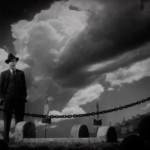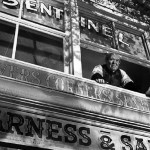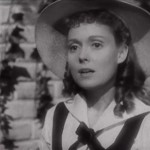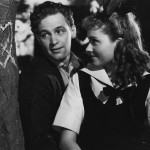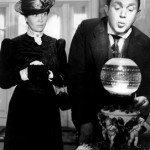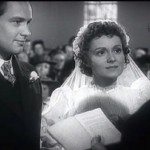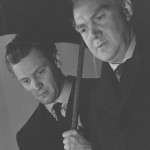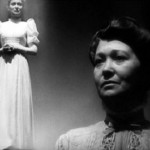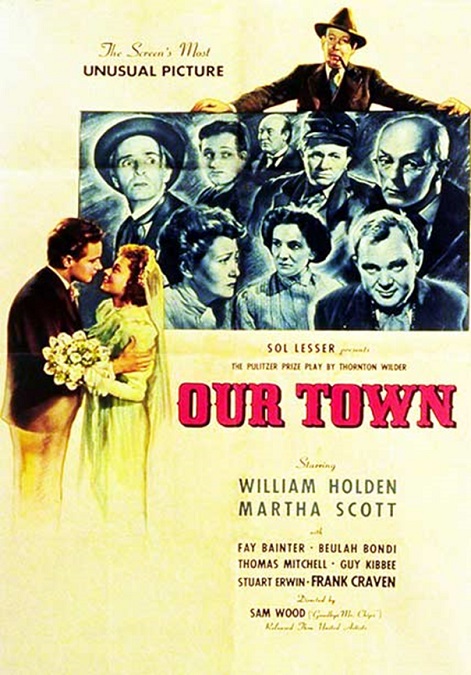
Our Town – 1940
I have to admit, right off the bat, that I had a slightly biased opinion about this film before going into it. The reason is that before it was a movie, it was a play, a play that was good enough to survive until modern times. And when I was in high school, I was fortunate enough to be in this play. I remember it as being so full of itself and almost silly at times that I never really took it too seriously.
But that was me, looking at the story through the eyes of a teenager who didn’t really understand the point. Now, having seen this film as an adult, with 25 or so more years of life experience, I can easily say that I get it now. Sure, the plot was a little slow, but it had a definite message and a point of view that was poignant enough to reach my heart and make me think. The gorgeous score by composer Aaron Copeland didn’t hurt either.
Watching the film also had the added benefit of making me remember the stage production in which I played the part of Howie Newsome, the Milk Man. It was a small part, though not the smallest, and I couldn’t help but pay special attention to the actor who played him in this film, Stuart Erwin. I approved of his easy and relaxed performance. Also, the character of the Stage Manager, played by Frank Craven, did a good job narrating the story and guiding the audience through the portrait of the small American town of Grover’s Corners.
But the mail plot focused on two neighbors: The Webb family and the Gibb family. More specifically, it focused on six individuals. The parents of each household and their oldest children. Fay Bainter played the part of Mrs. Gibbs while wonderful character actor Thomas Mitchell played her husband Dr. Gibbs. Their son George Gibbs was played by a very young William Holden. Mrs. Webb was played by Beulah Bondi, with one of my personal favorites, Guy Kibbee, playing her husband. Their daughter was played by Martha Scott.
These six people did a great job and together they made up the heart of the film. The plot is slow but not plodding. The characters are well written, which is a testament to the original play’s author, Thornton Wilder. They each have their own personalities. The first two thirds of the story follows the two young children, Emily and George, as they grow into adulthood. They fall in love and eventually marry.
Then, while giving birth to their second child, Emily dies. The final third of the film, enters the graveyard and looks in on the afterlives of the characters who have died over the years. This is where the show becomes very serious and insightful, telling the audience to treasure every moment of life. Not just the special times, but every moment of every day. Treasure the people you love and never forget how wondrous the miracle of life really is. The days of life are fleeting and should never be taken for granted. According to Wilder’s script, it is only the dead who understand this concept. When Emily tries to relive a day in her life, but finds it too painful to bear.
Now, here is where the film deviates from the stage play. In the film, it is shown that Emily’s death was just a near death. She wakes in her bed with her newborn baby and her adoring husband at her side. In other words, she lives.
But the ending of the original play was quite different. To demonstrate this difference, I will quote the Wikipedia article which said it quite eloquently. “Emily decides to return to Earth to re-live just one day, her 12th birthday. She finally finds it too painful, and realizes just how much life should be valued, “every, every minute.” Poignantly, she asks the Stage Manager whether anyone realizes life while they live it, and is told, “No. The saints and poets, maybe – they do some.” She then returns to her grave, beside Mrs. Gibbs, watching impassively as George kneels weeping at her graveside.”
Oh my goodness! Tear my heart out!! But if the film had any failings, it was this audience friendly ending. The image of George weeping at Emily’s grave is so much more meaningful, powerful, and yes, even disturbing. It is an ending that sticks with you and really makes you think about the nature of death and mortality. Never-mind that Thornton Wilder, himself, helped the film’s producer Sol Lesser to create these changes. If you ask me, it should have been left alone.
